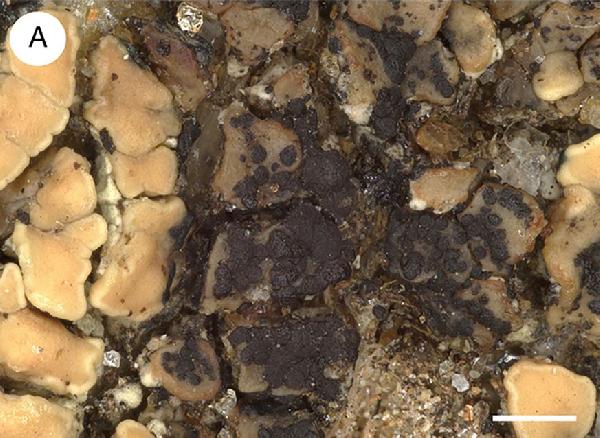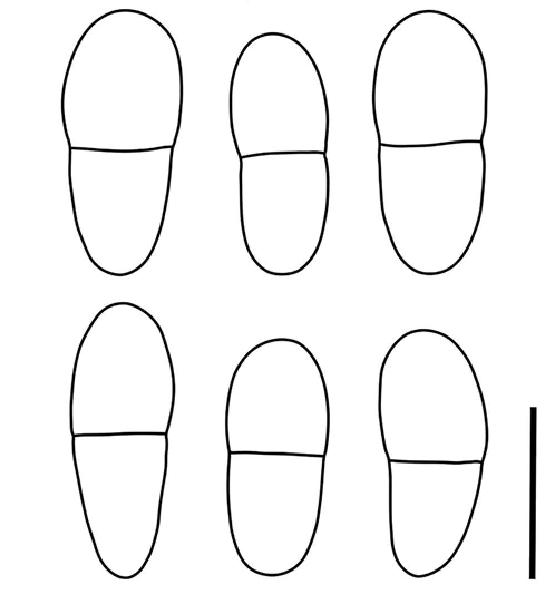Arthonia epipolytropa Hafellner & Grube
Lichenologist, 55: 243, 2023
Synonyms: Arthonia subvarians auct. non Nyl.
Distribution: N - TAA (Brackel 2016, Hafellner & Grube 2023), Lomb (Brackel 2013, 2016), Piem (Brackel 2016, Hafellner & Grube 2023). C - Tosc (Brackel 2016), Pugl (Brackel 2016).
Description: Thallus not lichenized, lichenicolous on species of the Lecanora polytropa-complex, the infections c. 0.5-1 mm wide, later sometimes merging into larger complexes, causing bleaching spots and destroying the apothecia of the host, consisting in often densely agglomerated groups of c. 5 to more than 30 apothecia. Apothecia arthonioid, black to brown-black, appearing cushion-like and becoming confluent, starting the development on those of the host, mainly in the upper part of hymenia, later spreading to thalline margins and occasionally also to sterile thalline areolae, where they are usually single. Individual apothecia rounded, emarginate, up to 0.3 mm wide and 0.1 mm tall, except for the hypothecial stipe. Epithecium brown, 10-15 μm high; hymenium pale grey-brown, 35-45 μm high, hemiamyloid; paraphysoids branched and anastomosing, c. 1 μm thick, becoming wider in the excipuloid margin (2-3 μm), the apical cells with indistinct caps an amorphous pigment rarely dispersing in small granules; hypothecium 50-70 μm high (excluding a central stipe), medium brown. Asci 8-spored, clavate, fissitunicate, with a tiny K/I+ blue ring basally in the tholus of the endoascus, Arthonia-type, 25-30(-35) x 10-15 μm. Ascospores 1-septate with a more or less median septum, hardly constricted at septum, hyaline, obovate, (9-)10-12(-13) × 4-5 μm, with subequal cells, the upper cell slightly or hardly wider, the lower cell somewhat longer. Photobiont absent. Chemistry without lichen substances.Note: a rarely recorded lichenicolous species growing on species of the Lecanora polytropa complex, mainly in the apothecia, widespread from Norway to the Mediterranean mountains. This species has been often called A. subvarians, but according to Hafellner & Grube (2023) that species grows on species of Polyozosia.
Growth form: Lichenicolous fungus
Substrata: rocks
Reproductive strategy: mainly sexual
paras Lecanora polytropa-group
Commonnes-rarity: (info)
Alpine belt: rare
Subalpine belt: rare
Oromediterranean belt: very rare
Montane belt: very rare
Submediterranean belt: extremely rare
Padanian area: absent
Humid submediterranean belt: extremely rare
Humid mediterranean belt: absent
Dry mediterranean belt: absent

Predictive model

Source: Hafellner, J., & Grube, M. (2023). Arthonia epipolytropa and Arthonia subclemens, two new lichenicolous species on Lecanora polytropa, with a key to the microfungi known on this common species. The Lichenologist, 55(5), 241-251. doi:10.1017/S0024282923000397

Modified from: https://gzu.jacq.org/GZU000338143
GZU000338143 - J. Hafellner. Österreich, Steiermark: Gurktaler Alpen, Kirbisch ca. 11 km SW von Murau, oberhalb von St Lorenzen, NE-exponierte Hänge knapp unter dem Gipfel, ca. 2100 m, 47°03ʹ05ʺN, 14°03ʹ05ʺE; GF 8950/1 ; Alt. 2100 m
Habitat auf: Lecanora polytropa.
Niedere Schrofen und Blockwerk aus paläozoischen Schiefern zwischen Zwergstrauchheiden; auf Neigungsflächen der Schrofen

Source: Hafellner J, Grube M. Arthonia epipolytropa and Arthonia subclemens, two new lichenicolous species on Lecanora polytropa, with a key to the microfungi known on this common species. The Lichenologist. 2023;55(5):241-251. doi:10.1017/S0024282923000397 - CC BY 4.0
Arthonia epipolytropa (type); cross-section Scale: 100 μm.

Source: Hafellner J, Grube M. Arthonia epipolytropa and Arthonia subclemens, two new lichenicolous species on Lecanora polytropa, with a key to the microfungi known on this common species. The Lichenologist. 2023;55(5):241-251. doi:10.1017/S0024282923000397 - CC BY 4.0
Arthonia epipolytropa (type material); ascospores. Scale: 10 μm.
Growth form: Lichenicolous fungus
Substrata: rocks
Reproductive strategy: mainly sexual
paras Lecanora polytropa-group
Commonnes-rarity: (info)
Alpine belt: rare
Subalpine belt: rare
Oromediterranean belt: very rare
Montane belt: very rare
Submediterranean belt: extremely rare
Padanian area: absent
Humid submediterranean belt: extremely rare
Humid mediterranean belt: absent
Dry mediterranean belt: absent

Predictive model

Source: Hafellner, J., & Grube, M. (2023). Arthonia epipolytropa and Arthonia subclemens, two new lichenicolous species on Lecanora polytropa, with a key to the microfungi known on this common species. The Lichenologist, 55(5), 241-251. doi:10.1017/S0024282923000397

Modified from: https://gzu.jacq.org/GZU000338143
GZU000338143 - J. Hafellner. Österreich, Steiermark: Gurktaler Alpen, Kirbisch ca. 11 km SW von Murau, oberhalb von St Lorenzen, NE-exponierte Hänge knapp unter dem Gipfel, ca. 2100 m, 47°03ʹ05ʺN, 14°03ʹ05ʺE; GF 8950/1 ; Alt. 2100 m Habitat auf: Lecanora polytropa. Niedere Schrofen und Blockwerk aus paläozoischen Schiefern zwischen Zwergstrauchheiden; auf Neigungsflächen der Schrofen

Source: Hafellner J, Grube M. Arthonia epipolytropa and Arthonia subclemens, two new lichenicolous species on Lecanora polytropa, with a key to the microfungi known on this common species. The Lichenologist. 2023;55(5):241-251. doi:10.1017/S0024282923000397 - CC BY 4.0
Arthonia epipolytropa (type); cross-section Scale: 100 μm.

 DOLICHENS
DOLICHENS

